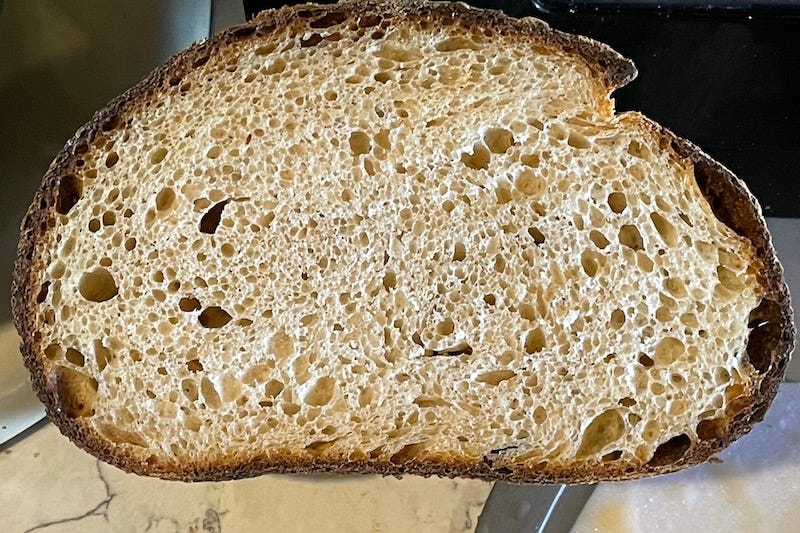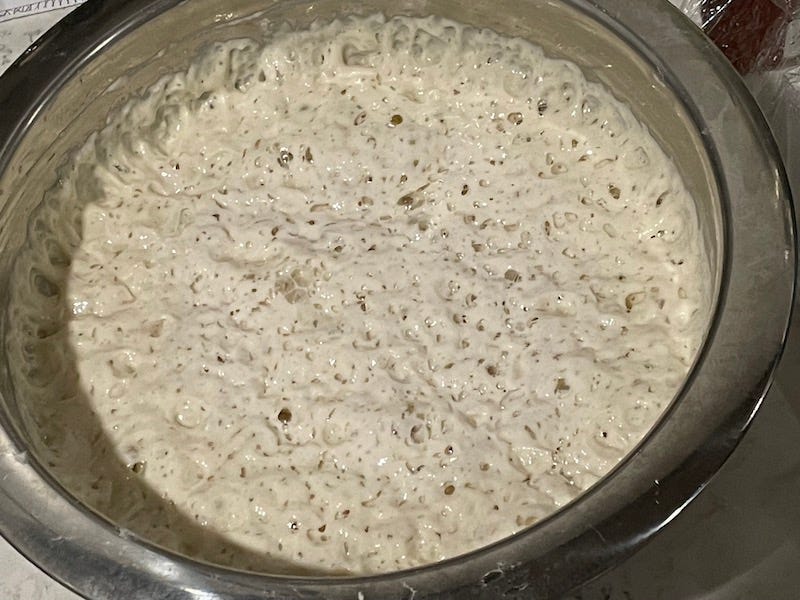
When we moved to Kauai I had to leave behind my beloved sourdough starter in Montana. For twenty years I nurtured it, feeding it three time a day when I was in one of my baking binges. And in the winter, when my wife Dorothy and I escaped the unforgiving cold, my starter rested in a back corner fridge for months, undisturbed, but always at the ready to fulfill its destiny when we returned.
So in December last year I began a new quest: creating a starter from scratch. Following the same method I used to create my original starter (described by Nancy Silverton in her seminal book, “Breads From the La Brea Bakery,”) I began. It’s a two-week process involving grapes, bread flour and water. Room temperature in our apartment is around 73 degrees F, ideal for the process.
I’ll spare you the details, but after a hopeful beginning where the flour slurry rose and bubbled and I practically jumped for joy, my happiness deflated as rapidly as the nascent starter collapsed. What went wrong? Short answer: I have no idea. I began again, and I am sad to report, failed a second time.
I read everything I could find online about making sourdough starters. Wild yeast cells are all around us, and a starter is just a combination of these cells and certain bacteria living together harmoniously in a mix of flour and water. The yeast cells feed on the flour’s starches and when their food supply gets low, the starter needs to be fed.
You need patience when working with sourdough starters. I tried several recipes that didn’t work, and finally found one that did. I mixed ½ cup of organic whole wheat flour with 1/4 cup of water to make a thick paste. I did this in a large water glass and covered it tightly with plastic wrap. The glass was half-full. I left it on the counter and sneaked a peek at it every once in a while.
Why just mix flour and water and leave it alone? Wild yeast cells are actually in flour, so the idea is to just add water to make the flour starches available to the yeast and wait. After two full days, I practically fell on the floor when I saw the flour paste had risen to the very top of the glass and it was full of bubbles!
Now I had to feed it on a schedule. I stirred down the paste, scraped half of it into a bowl, and weighed it. I added an equal weight of purified drinking water and organic white bread flour and mixed everything together to make a thick batter. I covered the bowl tightly with plastic wrap and let it stand undisturbed for about 10 hours. (I discarded the remaining starter—one of the tragedies of baking with sourdough).
During those 10-hours my brand new starter rose to more than double its volume and became very bubbly. It tasted a bit tangy and smelled slightly acidic. All good signs. I stirred it down, weighed a small amount to refresh with water and flour, and discarded the rest. If I just kept renewing all of the starter I’d soon have enough to fill a bathtub!
I kept my starter on a twice-a-day feeding schedule for a week to develop its strength to the point where I felt it was strong enough for baking bread. Sourdough breads (for the most part) do not use commercial yeast, so the starter provides not only flavor, but rising power.
When feeding a starter it’s important to not overfeed it. And by that I mean you wait until the yeast is hungry for more food. Back in Montana I got very anxious if I was away from home when it was starter feeding time. I’d have to excuse myself and rush home to my babies. When I finally uncovered my starter Dorothy would say, pointing to the bubbles, “They look really angry!” And that’s what you want. Yeast cells that are hungry for more food. That helps keep the starter healthy.
Once I had my new starter on a regular feeding schedule it was time to see how well it could bake bread. I began with a sourdough boule. Nancy Silverton calls it a Country Loaf. The formula is classic: Sourdough starter, water, bread flour, and salt, with a little raw wheat germ tossed in for texture.
And this was my result. A beautifully risen loaf with a burnished exterior full of tiny bubbles.
Making a new starter took two months of trial and error, but the payoff is huge. I can now share my starter with neighbors who love the magic and flavor of sourdough baking.

Happy baking!




Aloha! Found your post while searching how to make a successful starter in Hawai'i. I tried a couple years ago and failed. Any way to trade some of your starter for a dozen eggs from my chickens?
BRILLIANT!!! Thanks Greg, you inspired me to start a new starter again! I always start by mixing with a tiny amount of sheep's milk yogurt with the organic, whole-wheat flour from Thessaly, Central Greece. My last sourdough was neglected for a long time and finally discarded, since I am now hooked in baking the heavy, but very tasty eftazymo bread with a starter of slowly fermented chickpeas --an old Greek tradition that has almost died...